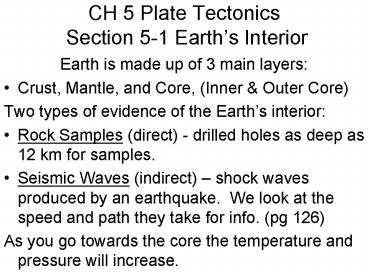CH 5 Plate Tectonics Section 51 Earths Interior - PowerPoint PPT Presentation
1 / 8
Title:
CH 5 Plate Tectonics Section 51 Earths Interior
Description:
Crust, Mantle, and Core, (Inner & Outer Core) Two types of evidence of the Earth's interior: Rock Samples (direct) - drilled ... Also reptile fossils helped. ... – PowerPoint PPT presentation
Number of Views:59
Avg rating:3.0/5.0
Title: CH 5 Plate Tectonics Section 51 Earths Interior
1
CH 5 Plate Tectonics Section 5-1 Earths Interior
- Earth is made up of 3 main layers
- Crust, Mantle, and Core, (Inner Outer Core)
- Two types of evidence of the Earths interior
- Rock Samples (direct) - drilled holes as deep as
12 km for samples. - Seismic Waves (indirect) shock waves produced
by an earthquake. We look at the speed and path
they take for info. (pg 126) - As you go towards the core the temperature and
pressure will increase.
2
- Crust think outer layer of the Earth, made of
solid rock, that includes both dry land and ocean
floor. (about 40 km thick) - Oceanic crust is made of Basalt.
- Continental crust is made of Granite.
- Mantle made up of very hot semi-solid rock,
divided into layers based on physical properties.
(about 3000 km thick)(80 total volume of the
Earth) - Lithosphere very upper part of the mantle,
basically the crust. - Asthenosphere below the lithosphere, where rock
bends like a plastic (plasticity). - Lower Mantle bottom section extending to the
core.
3
- Core made mostly of metals nickel and iron
- Outer core liquid part of the core.
- Inner core dense ball on solid metal due to
pressure. - Magnetic Field like a bar magnet through the
middle of the Earth. Protects us from certain
things in space (Radiation, Meteors). - Due to the molten outer core.
- Page 131.
- Causes compasses to work on the Earth.
4
Sec 5-2 Convection and the Mantle
- Heat moves three ways on the Earth
- Radiation transfer of heat energy through empty
space (sunlight) - Conduction transfer of heat directly through
touching (through a piece of metal) - Convection transfer of heat through a fluid
like a liquid or a gas (water, air) - Movement occurs because of differences in density
of the liquids as they heat up and cool down. - Hot goes up, and cold goes down.
- - Heat from the core and the mantle itself
causes convection currents in the mantle
5
Sec 5-3 Drifting Continents
- Continental Drift states that all the continents
were once joined together in a single landmass
and have since drifted apart. - Alfred Wegener 1910 german scientist who
discovered this. Called the supercontinent
Pangea (all land) - Evidence that supports this continental drift
- Land features like shape of coastlines, mineral
deposits (coal), and glacial erosion. - Fossils like Glossopteris (fernlike plant) are
found in rocks on Africa, South America, India,
Australia, and Antarctica (page138-139). Also
reptile fossils helped. - Climatic change also helped by showing some
plants and animals could not live on the current
land masses today because of temperature
differences.
6
Sec 5-4 Ocean Floor Spreading
- Mid-ocean ridges are where the plates pull apart
under the oceans. They form under water mountain
chains. - Sonar uses sound waves under water to map out
objects echoes as they bounce back. - Sea-floor spreading occurs when both sides of the
mid-ocean ridges pull apart and new crust is made
between them. - They move like conveyor belts carrying the
continents along with them. - Evidence for this include molten material,
magnetic stripes on the ocean floor, and the age
of the rocks.
7
- Subduction Zones areas where ocean plates are
pushed down into the mantle. Rock is recycled
from Ch 4. Oceanic Crust (Basalt) is younger
then Continental Crust (Granite) - - creates trenches along the edges of the
oceans. (Mariana Trench 11033 meters) - Pacific ocean is shrinking due to subduction
zones. - Atlantic ocean is growing due to ocean-floor
spreading.
8
Sec 5-5 Theories
- Theory of Plate Tectonics explains the formation,
movement, and subduction of the Earths plates. - There are 3 different types of plate boundaries
where movement occurs. (pg. 152-153) - Divergent Boundary two plates move apart from
each other, or diverge. - Convergent Boundary two plates come together,
or converge. - Transform Boundaries two plates slide past each
other in opposite directions - History of the plates movement show a
supercontinent called Pangea, (225 mya) which
later split into two major landmasses called
Laurasia (north) and Gondwannaland (south) (190
mya)































